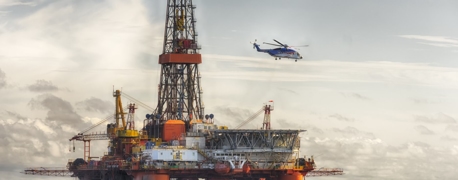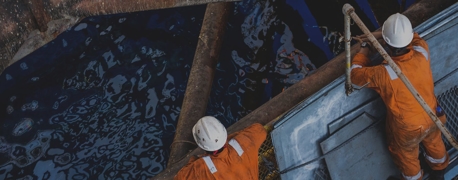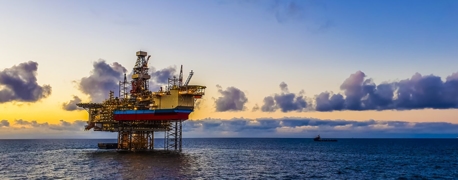7 Types of Commercial Vessel Incidents & How to Prevent Them

Commercial vessels can be dangerous places. They can catch fire, explode, capsize, run aground, or have any of a number of incidents happen that place their crews in harm’s way. When these incidents occur, they also endanger the environment and any passengers the vessel may be carrying. Vessels and their cargo may be lost at sea, and maritime companies stand to lose millions when this happens. With this article, we'll shed light on the types of commercial vessel incidents, the harm they cause, and what can be done to prevent them.
At sea, accidents don’t just “happen.” They can’t be blamed on Mother Nature alone. They have real, identifiable causes, and that means that they can be avoided.
The Main Types of Commercial Boat Incidents
Barges, tugs, fishing vessels, cargo ships, ferries, supply boats, and cruise ships are all examples of commercial vessels. They traverse oceans, seas, rivers, and lakes. They transport cargo and passengers, take crews to offshore platforms, tow other vessels, fish for salmon and crab, and perform many different essential functions that we all rely on every day – whether we know it or not.
When commercial vessels are negligently operated or are not seaworthy, they may experience significant problems that put everyone on board in danger. The sea is unforgiving and unpredictable. There are no minor mistakes.
Here are the seven main types of commercial vessel incidents:
1. Foundering/Sinking
In a maritime sense, founder means to sink. A ship that has foundered has sunk to the bottom of the ocean, sea, or other body of water. Ships may founder because of heavy weather, particularly hurricanes or tropical storms. They may also founder after fires or explosions that cause them to take on too much water to stay afloat. Smaller vessels, such as fishing boats, may founder if they try to lift too-heavy loads and capsize.
Foundering is the most serious type of commercial vessel incident because it means the ship has been lost completely. The entire crew may go down with the ship, its cargo may be lost, and it may release fuel or other pollutants into the environment.
One of the most famous and catastrophic sinkings of a commercial vessel was the loss of the Titanic in 1912. The British passenger liner struck an iceberg and sunk in the Atlantic Ocean on her maiden voyage, resulting in the loss of more than 1,500 of the 2,224 passengers and crew members on board.
While we haven’t seen a disaster like the foundering of the Titanic in some time, dozens of commercial vessels are lost each year, most often cargo ships. According to Statista, 876 vessels were lost at sea from 2011 to 2020 across the planet. 348 were cargo ships. Rounding out the top 5 types of vessels lost during that time were: fishing vessels (120), bulk carriers (76), passenger ships (69), and tug boats (51).
2. Missing
Oceans are vast, and there are times when commercial vessels are lost without any indication of what happened or where they may be. Ships can go missing even with modern radar and global positioning technology. A ship is considered missing if there has been no news of its location or status for a reasonable amount of time. When a ship disappears in this way, it is usually assumed that its entire crew has been lost and that it has foundered.
Many vessels that are still missing today disappeared over immense search areas or deep water that would make location and recovery astronomically expensive – if at all possible.
One of the most famous maritime disappearances was the loss of the USS Cyclops in 1918. There were 309 men aboard the Navy vessel when she went missing sometime after March 4. Nothing was ever heard from her, no survivors were located, and the wreck was never found.
Another infamous disappearance involved a vessel named the Intrepid. In October 1996, the 65-foot yacht sent out a distress signal off the coast of Fort Pierce, Florida, saying the vessel was sinking and the 16 passengers were abandoning ship. The Coast Guard searched 6,000 square miles, but the vessel and her passengers were never located.
Throughout the centuries, vessel disappearances have spurred the creation of maritime folklore and theories about regions like the Bermuda Triangle, where ships and planes simply vanish without a trace. More likely, however, is the fact that the cost and undertaking of finding missing vessels is a burden that most companies and governments cannot – or will not – shoulder.
3. Fire/Explosion
Fires and explosions are serious risks on commercial vessels. Even a small fire in any location on a vessel can lead to catastrophic loss of life if improperly managed and controlled. An explosion is a catastrophic event in itself that may lead to the complete loss of a vessel and its crew.
In March 2006, a fire started by a discarded cigarette claimed the life of a passenger and caused significant damage to the Star Princess cruise ship while the vessel was en route to Montego Bay, Jamaica. 13 other passengers were injured.
Earlier that same year, the al-Salam Boccaccio 98 sank after firefighting efforts in the engine room caused a buildup of seawater in the hull of the vessel. The passenger ferry, which was carrying about 1,400 passengers and crew in the Red Sea from Saudi Arabia to Egypt, listed and then capsized. Just 388 people were rescued.
Those are two examples of the impact that a fire can have on a commercial vessel. While both of those were carrying passengers, cargo ships are at risk of suffering significant losses from fires. According to an analysis of maritime statistics from 2010 to 2019, fires were the third leading cause of cargo losses for container ships, after sinkings and groundings. It’s estimated that there is a major fire aboard a cargo vessel every 60 days, worldwide.
Fires and explosions pose very real threats for offshore workers in the oil and gas industry as well, as they work on platforms or vessels that extract and transport highly volatile substances.
4. Collision
On January 14, 2020, an 87-foot commercial fishing vessel, Pappy’s Pride, and a 600-foot tanker, Bow Fortune, collided in dense fog off the coast of Galveston, Texas. The collision claimed the life of the fishing vessel’s captain and two of her crew when the Pappy’s Pride subsequently capsized and sank. Lack of communication was found to be the primary cause of the collision. The Bow Fortune tried to hail the Pappy’s Pride and sounded two danger signals, but the fishing vessel never responded.
Commercial vessel collisions occur when a ship strikes or is struck by another ship. Either vessel may have been in motion, anchored, or moored at the time. The severity of collisions will vary depending on the size and type of each vessel, the location of and speed of impact, weather and sea conditions, the type of cargo the vessels were carrying, and numerous other factors. When the vessels are significantly different in size, as in the case of the Pappy’s Pride and the Bow Fortune, the smaller vessel is more likely to sustain severe damage.
5. Contact
Contact in terms of commercial vessel incidents is described as striking an object other than another vessel. It also does not include running aground. This is referred to as an “allision.” When a vessel strikes a dock, bridge, or another stationary object, this may be considered contact or an allision.
Like collisions, allisions can cause vessels to capsize, break apart, or founder. Everyone on board may be in danger, and the vessel may be at risk of causing pollution if it is carrying hazardous cargo or its fuel leaks into the ocean.
6. Stranding/Grounding
Although stranding and grounding are technically two different incidents, they are similar enough that we are including them in a single category. Grounding occurs when a vessel strikes the seabed (runs aground). Stranding occurs when a vessel then remains there for some time. Strandings and groundings are serious commercial vessel incidents that can cause considerable damage to the vessels and result in oil spills, depending on the condition of the seabed.
Although one would assume that groundings and strandings should be preventable with modern equipment and technology, they continue to occur.
In March 2022, a 1,096-foot container ship called the Ever Forward grounded in the Chesapeake Bay near Baltimore, Maryland. This happened almost a year after another ship owned by the same company, Evergreen Marine Corp Taiwan Ltd, ran aground and blocked the Suez Canal for six days. The Ever Forward remained stranded outside of the canal in 25-foot-deep waters for about a month before it was finally freed.
Also in March 2022, the Norwegian Escape, a cruise ship owned by Norwegian Cruise Lines, ran aground in the Dominican Republic. The 164,000-ton vessel was carrying 3,223 passengers and 1,618 crew members when strong wind reportedly deviated her course toward a sandbar in the shipping channel.
No injuries or environmental impact were reported as a result of the grounding of the Ever Forward or the Norwegian Escape, but other incidents have caused serious harm.
In January 2012, an Italian cruise ship named the Costa Concordia ran aground off the coast of Tuscany. 27 passengers and 5 crew members lost their lives. The vessel deviated from her course and subsequently struck a rock formation on the seabed, which caused the ship to capsize and sink.
7. Capsizing/Listing
Capsizing is a devastating incident that involves an overturn of a maritime vessel. When a commercial vessel capsizes, it turns on its side or completely bottom-up in the water. Commercial vessels may capsize because of other events, such as a fire, severe storm, or collision. That’s what happened to the Seacor Power, a 129-foot lift boat that capsized in a severe storm off the coast of Louisiana in April 2021. Only 6 of her 19 crew members were rescued.
Listing is similar to capsizing but does not involve a complete overturn of the vessel. When a vessel lists, it tilts to one side, typically as a result of taking on water or of having an imbalanced weight distribution. A boat may list to port (left) or starboard (right). If a vessel lists too far, it may be impossible to right and may fully capsize and then sink.
The Effects of Commercial Boat Incidents
A commercial vessel incident has the potential to cause catastrophic loss of life and environmental damage. A capsized cruise ship, for example, could endanger thousands of passengers and crew members. A commercial fishing vessel that sinks could result in the loss of the entire crew. A cargo vessel that catches fire could place its crew and the environment at risk. An offshore rig that explodes, such as the Deepwater Horizon, may claim lives, cause billions of dollars in damage, and threaten the environment from a resulting spill.
The financial effects of commercial vessel incidents are enormous. The Costa Concordia disaster, for example, caused an estimated $2 billion in losses. Hundreds of containers from cargo ships are lost at sea every year, from incidents that range from listing to fires to founders, leading to hundreds of millions in losses. In just one incident in November 2020, the ONE Apus lost more than 1,800 containers (valued at $90 million) in gale force winds at the Port of Long Beach, California.
Far worse than the financial effects of commercial boat incidents are the impacts they have on people. The crews of commercial vessels should not have to fear for their safety or their very lives because their employers are not doing enough to prevent incidents that put them in harm’s way. Passengers should not have to worry about a cruise turning into a fight for survival. Maritime companies need to do better.
Preventing Commercial Vessel Incidents
Commercial vessel incidents are preventable, and it’s up to shipping companies, oil and gas industry giants, and other maritime employers to take the steps necessary to ensure their ships are seaworthy, their crews are given the training and equipment they need, and that they do not take unnecessary risks to try to protect profitability. There is no excuse for a cargo ship to steam into a hurricane. There is no excuse for having an insufficient plan in place to address an emergency like a fire. There is no excuse for allowing a vessel to take to the sea if it is not fit to do so.
Preventing injuries and death in the commercial maritime industry is possible when the right procedures are implemented by vessel owners, operators, and crews.
According to the National Institute for Occupational Safety and Health (NIOSH), fatalities can be avoided by:
- The use of personal flotation devices (PFDs) by all crew members while on deck
- Minimizing crew member fatigue
- Implementing safety training and carrying out routine emergency drills
- Ensuring emergency equipment (lifeboats, immersion suits, fire extinguishers, etc.) is available and in working order
- Ensuring the seaworthiness of the vessel and all of her parts/systems/equipment
- Guarding equipment like deck winches and cranes
- Evaluating and observing weather forecasts
Helping Injured Maritime Workers & Families
Arnold & Itkin has an unparalleled reputation for representing injured maritime workers and families who have experienced tragic losses and catastrophic injuries. We have helped people after the worst commercial vessel disasters, finding answers and recovering compensation that helps them turn their lives around. We have held the biggest corporations accountable for the wrongdoing and negligence that allowed incidents like foundering, grounding, and capsizing in the first place. Our maritime lawyers are standing by to see how we can help you.


